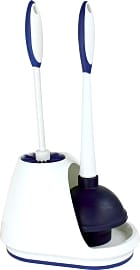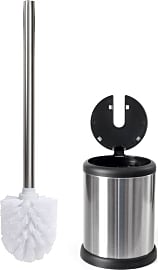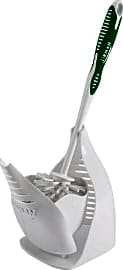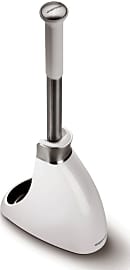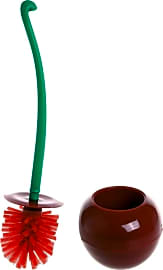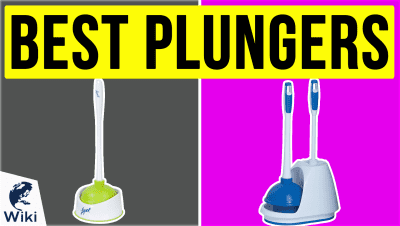The 10 Best Toilet Brushes

This wiki has been updated 37 times since it was first published in March of 2016. It's not the most glamorous category, but it is an essential one. Whether you just want a no-frills model that will thoroughly scrub your bowl, or something a bit more stylish and colorful to complement your trendy bathroom decor, you'll find the perfect model to suit your needs in our comprehensive selection of toilet cleaning brushes. There's one to suit all budgets, too. When users buy our independently chosen editorial selections, we may earn commissions to help fund the Wiki.
Editor's Notes
July 23, 2021:
Toilet brush technology isn't exactly advancing much these days, but we did add one interesting model that piques our interest. The ToiletTree Deluxe looks awfully nice for a simple toilet brush,and the long-handled model can make cleaning especially easy. That's the only change we've made. The Oxo Good Grips Hideaway is still our favorite, and the Mr. Clean Turbo Caddy Set still a top choice for functionality, even if it doesn't look very elegant.
April 23, 2020:
Although we've looked for durable toilet brushes, it's important to remember that these are hard-working items with a pretty gross job — so you probably shouldn't expect them to last as long as many of your other cleaning supplies. If you see that the bristles on your brush are bent or falling out, it's probably a good idea to grab a new one. And if someone in your home has been sick with a contagious illness, you should consider disinfecting your toilet brush with bleach, or even replacing it.
That said, the Oxo Good Grips Hideaway remains a top choice, one that is robust enough to give you plenty of value for the cost. It is offered in several colors, easily matching most bathrooms, and is compact, so it shouldn't be in your way. We've also, after some consideration, kept the Simplehuman with Caddy, which has a unique shape that turns out to be something of a double-edged sword. On one hand, it gets under the rim quite well, but on the other, it doesn't do a fantastic job with the very bottom of the bowl. Depending on where/how your toilet tends to get dirty, this may or may not be appropriate and useful. If not, there's also the Mr. Clean Turbo Caddy Set, an all-around choice that's actually a handy toilet brush and plunger combo.
For those who want something more decorative and less utilitarian, we've kept the iDesign Twigz and added the fun Adnikia Creative Cherry. These will draw more attention than plain models, like the Libman 40 Designer, so don't be surprised if you receive a few comments. Unfortunately, the iDesign model isn't as durable as some, so consider it for light duty.
Special Honors
Lumi Self Sanitizing If the thought of germs really bothers you, and you don't have time to continually bleach your toilet brush, you might try the Lumi Self Sanitizing. Its base has UV lights to inhibit the growth of nasty, harmful bacteria, and since it opens and closes automatically, it's super simple to use. thelumibrush.com
Wild Minimalist Wood Those who are trying to live plastic-free might like the Wild Minimalist Wood, which features all-natural materials, including beechwood and Tampico, a type of plant fiber. To catch drips, a handsome terra cotta dish rests at the bottom of the stand. wildminimalist.com
Blomus Menoto Toilet Butler The elevated price ensures that the Blomus Menoto Toilet Butler isn't for everyone, but for those who want a sleek, long-lasting choice, and don't mind doling out the cash for it, it's definitely one to consider. The stand holds one roll of toilet paper, while the polystone base has a holder for the included brush with stainless steel handle. blomus.us
Maintaining The Inside Of Your Porcelain Throne
Animal hair bristles are the softest of the three types and are best for gentle surface cleaning.
Let's face it. Going number one or two isn't going to make that shiny porcelain toilet in your bathroom look any better. Not only do toilets take a lot of abuse over the years, but the idea of cleaning them doesn't exactly evoke olfactory memories of grandma's freshly-baked sugar cookies, either. As much as cleaning this bathroom staple is a dirty job, you should be able to simplify the process and efficiently get the inside of that bowl as clean and shiny as possible while exerting minimal effort. One great way to accomplish this is by investing in a handy, inexpensive toilet brush as part of your arsenal of bathroom beautification tools.
Often used in conjunction with a commercial toilet cleaner or bleach, the toilet brush consists of an abrasive bristled end with a rounded edge and a long handle, facilitating the cleaning of all those hard-to-reach spots deep inside a toilet bowl. Having a slender, compact design that fits easily into corners and tight spaces, the brush is usually stored in a dedicated holder or tube, which allows it to dry appropriately and remain out of sight when not in use.
Depending on the decor of your bathroom and the nature of its equipment, there are several different types of toilet brushes that can suit virtually any type of surrounding. Two of the most common construction materials for brushes include stainless steel and acrylic. Both materials are durable, lightweight, resilient, and built for constant use.
Bristle choices include animal hair, synthetic fibers, and vegetable fibers, all of which make it easy to clean under the toilet rim and efficiently remove stains from a porcelain surface. Animal hair bristles are the softest of the three types and are best for gentle surface cleaning. Synthetic and vegetable fiber bristles are ideal for heavy-duty general purpose cleaning projects and typically offer longevity and resiliency when they have to be used over and over.
Cleaning The Commode With Practicality
There are several practical concerns you should keep in mind when investing in a good toilet brush. First is overall handle comfort. Consider that you'll probably be down on your hands and knees a lot when cleaning the commode, so an extra-long and ergonomically-designed handle made from plastic or smooth steel will provide an easy grip for this type of manual labor. If you're working with a metal implement, it should be rust-resistant, as you know that continual splashing and drying are inevitable on the job.
There are several practical concerns you should keep in mind when investing in a good toilet brush.
Next, consider the bristles on your tool of choice. There's little point in purchasing a brush with a comfortable handle if the bristles at the end don't hold up well over time. It's also important to realize that toilets come in many different shapes and sizes, so it's important to ensure that the bristles on your brush of choice are long enough to reach all the nooks and crannies inside the bowl. However, it's equally important to find an effective balance between bristles that are too soft versus those that are too abrasive. Bristles should have a fairly dependable recovery strength, which is really a fancy way of describing their ability to retain their original shape and rigidity through constant use. Depending on how delicate the interior of your toilet is, soft bristles will minimize the potential for surface scratches caused by continual scrubbing, but they may not be powerful enough to remove all the grime from inside the bowl, making them best for toilets that aren't used daily.
Don't assume that once you've used a brush to clean your toilet, the job stops there. As the brush is used to scrub around the inside of the bowl, the bristles pick up a lot of bacteria in the process, requiring the tool to be cleaned on a regular basis. Proper sterilization of the brush will prevent cross contamination with other bathroom surfaces. One way to accomplish this is to consider a model with a disposable scrubbing head. This means you don't have to come into contact with the bristled end after cleaning and you can simply toss it in the garbage when you're done. Some toilet brushes even claim to have flushable scrubbing heads, though they may not be the wisest choice when dealing with plumbing or septic systems.
A Brief History Of The Toilet Brush
Rudimentary sewage and waste disposal systems date as far back as the Stone Age and the days of ancient Egypt. In Egypt, the wealthy were often equipped with proper bathrooms and toilets in their homes. Toilet seats of the time were made of limestone, while the poor would make do with wooden stools as an alternative. Underneath the stools were containers filled with sand, which had to be emptied by hand. Both the Indus Valley and Minoan civilizations constructed elaborate drainage systems and sewer networks as far back as 2000 BCE.
The modern, plastic-made toilet brush was invented in 1932, courtesy of William C. Schopp.
The flushing toilet was invented thousands of years later by SIr John Harrington in 1596, however flushing lavatories were still considered luxury items until the late 19th century.
The modern, plastic-made toilet brush was invented in 1932, courtesy of William C. Schopp. His design was later patented in 1933 by the Addis Brush Company.
Although the fundamental purpose behind Schopp's invention hasn't changed much over the last century, today's toilet brushes have evolved to deliver sleek and ergonomic designs to their users with innovative containers that are capable of snapping shut around their bristled ends, which ultimately prevents the release of odors, germs and messy drippings onto a bathroom floor. With a growing concern for the incubation of bacteria on modern toilet brushes, the trending direction of design for these tools has lead to new innovations, such as silicone blades and dedicated reservoirs of anti-bacterial fluid into which the brushes can be dipped for superior cleaning and sterilization.


